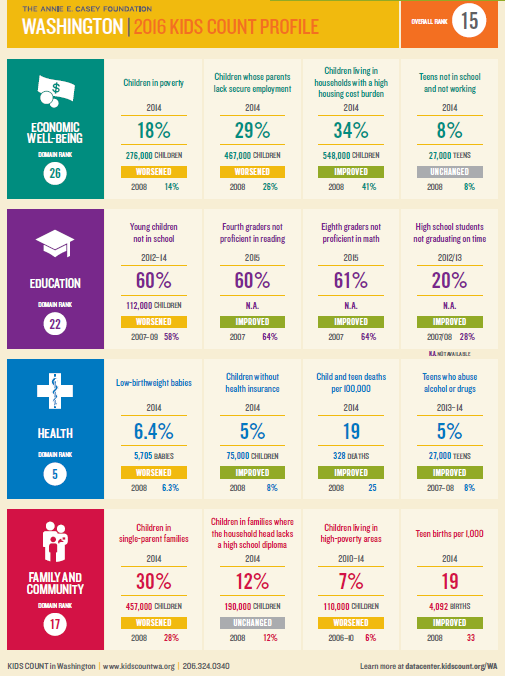SEATTLE – Kids and families in Washington state have made some progress in the face of poverty rates that have yet to improve, according to the new national 2016 KIDS COUNT® Data Book from the Annie. E. Casey Foundation. Washington is ranked 15th among the 50 states in the Data Book, moving up four places in the national rankings of child well-being since 2015.
Key among the positive changes: since 2008, the number of children growing up without the health coverage they need to see a doctor or get medicine when they’re sick has improved by 38 percent. What’s at work is the state’s Cover All Kids law, which passed in 2007 and created affordable health coverage called Apple Health for Kids. The Affordable Care Act’s 2014 creation of a flexible market for individual plans has also propelled child coverage in Washington to one of the nation’s highest.
Yet the child poverty rate is nearly 30 percent higher than it was in 2008, with an additional 59,000 children growing up below the federal poverty level. Poverty can impede children’s cognitive, social and emotional development and contribute to poor health. And poverty disproportionately harms kids and families in communities of color, who face other barriers to economic security in the form of an educational opportunity gap and a high cost burden for housing, food and other basic needs. These stressors are caused by, and contribute to, the structural racism faced by families of color. This undermines progress for children and the state as a whole.
“We can’t afford to leave any children on the wrong side of these barriers,” says Paola Maranan, executive director of the Children’s Alliance, a statewide organization advocating for racially equitable policy solutions that move all of Washington’s 1.6 million children along a path of opportunity.
“Children of color are already the majority in 12 states. By the end of the decade, children of color will be the majority of all children in the United States,” says Laura Speer, associate director for policy reform and advocacy at the Annie E. Casey Foundation. “Our shared future depends on today’s young people fulfilling their potential.”
The Children’s Alliance and the Washington State Budget & Policy Center, which create the report, support two-generation approaches to creating economic security for both children and their parents—because kids do better when their parents do better. One 2016 proposal that would help both kids and families is Initiative 1433, now gathering signatures for the state’s November ballot. It would raise the take-home pay for the working parents of an estimated 90,000 Washington children. And it would also provide up to seven days of paid sick and safe leave per year, helping Washington families by ensuring that workers don’t lose wages when they need to take care of themselves or their children when they’re sick.
More To Read
February 11, 2025
The rising cost of health care is unsustainable and out of control
We have solutions that put people over profits
January 29, 2025
Who is left out of the Paid Family and Medical Leave Act?
Strengthening job protections gives all workers time they need to care for themselves and their families
November 1, 2024
Accessible, affordable health care must be protected
Washington’s elected leaders can further expand essential health care

